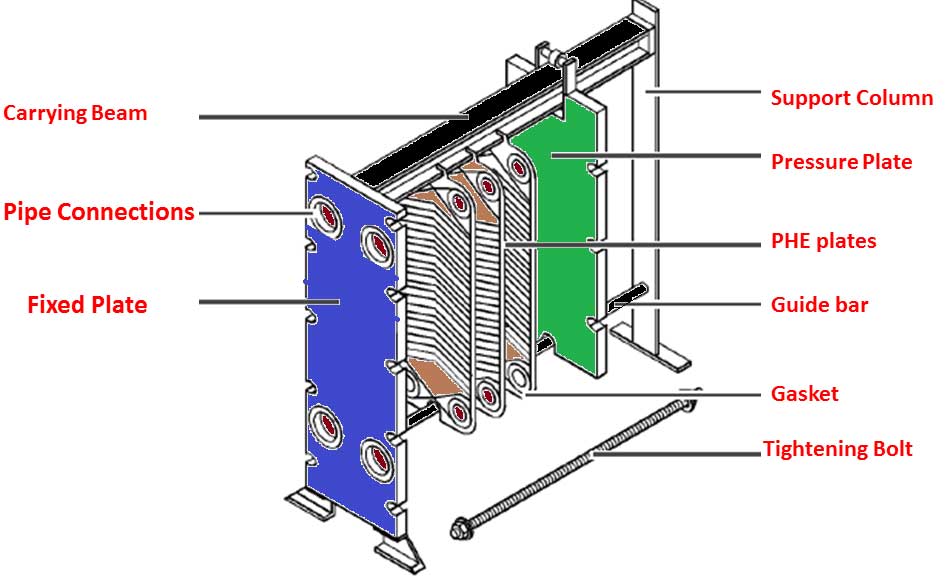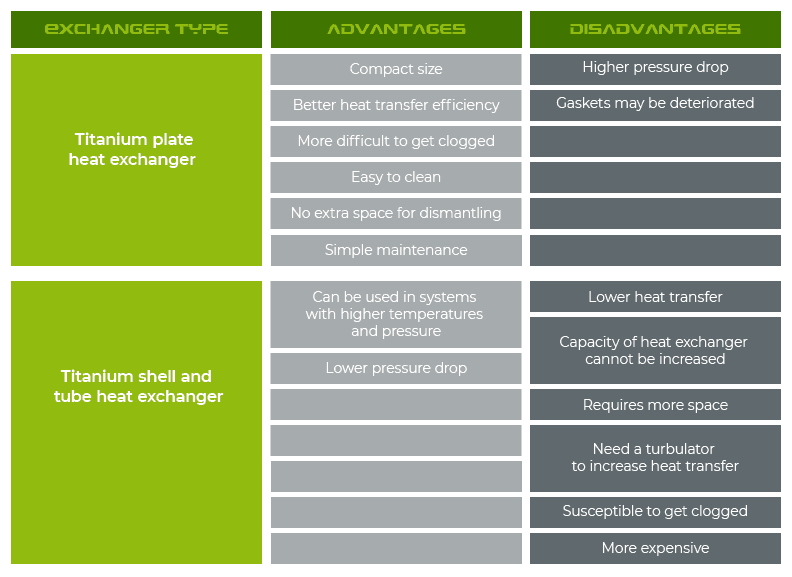Advantages and Disadvantages of Plate Heat Exchanger
Plate Evaporators consist of a plate and frame heat exchanger and are mainly used in the food and beverage industry. Heating water heating DHW heating drinking water heating separation exchanger biogas stations.

Plate Heat Exchanger Theory Phe Structure And Functional Description
Each of the three types of heat exchangers has advantages and disadvantages.

. Applications of plate type heat exchanger. A steam condenser is a closed vessel-type heat exchanger applied to convert low-pressure exhaust steam from the turbine to water. Heat recovery is a method which is used to reduce the heating and cooling demands of buildings.
Its plates may be used for heating cooling and. Suitable for higher pressures and temperatures compared to plate heat exchangers. Plate Heat Exchanger Advantages.
In cross flow exchangers the hot and cold fluids move perpendicular to each other. A proximity sensor is a sensor able to detect the presence of nearby objects without any physical contact. This is often a convenient way to physically locate the inlet and outlet ports in a small package and moreover this is an efficient design compared to the parallel heat exchanger.
It falls on the perforated conical plate to turn into a large number of jets. The central component of the system is the heat exchanger. The fluids may be separated by a solid wall to prevent mixing or they may be in direct contact.
Advantages and Disadvantages of Cross Flow Heat Exchangers. They have some unique advantages over some of the more complicated heat exchanger designs as well as some important disadvantages so this article will show buyers. There are various types of proximity sensors out there in the market but one can say this device often performs its object presence detection task by emitting an electromagnetic field or a beam of electromagnetic radiation infrared for instance and.
Generation IV Reactors Integrated Materials Technology Program Plan. Download Free PDF View PDF. Gasketed brazed welded and semi-welded.
In either case flat plate construction is the simplest and most compact. Shell and tube type heat exchanger. A plate heat exchanger is a compact type of heat exchanger that uses a series of thin plates to transfer heat between two fluids.
The flat plat collectors is basically a heat exchanger which transfer the radiant energy of the incident sunlight to the sensible heat of a working fluid-liquid or air. There are numerous advantages associated with plate heat exchangers. This manufacturing method is particularly useful when thin walls and long lengths are needed.
2014 Guiqiu Zheng Piyush Sabharwall. Each of the three methods for producing pipe has its advantages and disadvantages. Plate heat exchangers weigh less require less space and are more efficient compared to other heat exchanger designs of the same size.
Download Free PDF View PDF. SWEP and Alfa Laval brazed plate heat exchangers. By recovering the residual heat in the exhaust gas the fresh air.
The major advantages of Plate Evaporators are they are well adapted to materials low headroom required easily cleaned and modified. The term flat plate is slightly misleading in the sense that the surface may not be truly flat-it may be combination of flat grooved or of other shapes as the absorbing. A plate type heat exchanger as illustrated in Figure 2 consists of plates instead of tubes to separate the hot and cold fluids.
A counterflow unit has a higher effectiveness than a cross-flow unit of the same area although the simpler manifolding of the cross-flow unit may give it a price advantage which offsets its lower effectiveness. Capacity to heat treat milk quickly and adequately while maintaining rigid quality control over both the raw and finished product. This section presents some of the main advantages and disadvantages of a PHE compared to shell-and-tube heat exchangers.
Heat recovery ventilation HRV also known as mechanical ventilation heat recovery MVHR is an energy recovery ventilation system which works between two sources at different temperatures. Heat exchangers have widespread industrial and domestic applications. The PHE is a compact easily cleaned unit.
Plate type heat exchanger diagram. As a waterwater exchanger ie. The hot and cold fluids alternate between each of the.
Pressure drop delta PΔP is less than a plate heat exchanger. Shell and tube heat exchanger consists of a bundle of round tubes placed inside the cylindrical shell. There are four main types of PHE.
But of the three. Relatively simple design and easy to maintain. The major disadvantage of Plate Evaporators is the large gasketed area.
In these types of oil coolers the coolant passes through a heat exchanger element of some parts. The falling jet of cooling water gets stuck in the trays from where it exits in the second series of jets and meets with the exhaust. A heat exchanger is a heat transfer device that exchanges heat between two or more process fluids.
Advantages disadvantages of plate heat exchangers The double pipe heat exchanger is one of the easiest designs to fabricate add on to and repair thanks to its simple design. Advantages and Disadvantages of Shell and Tube Heat Exchangers. Milk chilling plants b.
Radiator in automobile c. The tube axis parallels to that of the. 11 Heat Transfer Equipment.
We sell a very wide range of compact conventional heat exchangers at low pricesBrazed plate heat exchangers are extremely efficient for heat exchange. A heat exchanger is a system used to transfer heat between a source and a working fluidHeat exchangers are used in both cooling and heating processes. Butt-welded pipe for example is formed from a rolled plate that has a more uniform wall thickness and can be inspected for defects prior to forming and welding.
Cheap compared to plate heat exchangers. Focus on Very High Temperature Reactor Materials. Replacing and cleaning of the plates is a simple task because the plate stack can be opened easily.
Is a small radiator that enables the engine oil to be cooled directly from an ambient air from the cooling fans. They are widely used in space heating refrigeration air conditioning power stations chemical plants petrochemical plants. The Plate Heat Exchanger PHE also called Paraflow is commonly used in the HTST system.
The coolant is enabled either by adding heat to cold oil or draw heat from excessive hot oil. Advanced heat exchanger development for molten salts.

Seawater Heat Exchanger Araner

Plate Heat Exchanger Phe Explained Savree

Plate Heat Exchanger Phe Explained Savree

The Flat Plate Heat Exchanger In Comparison With Other Types Of Heat Exchangers Bright Hub Engineering
Comments
Post a Comment